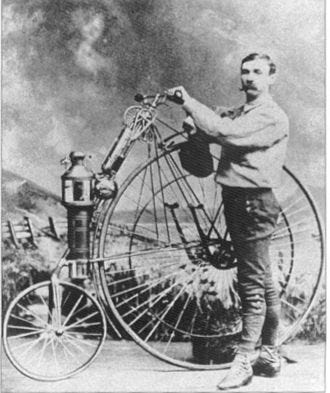Revving Through Time, A journey through motorbike history.
Explore the evolution, innovation and cultural impact of motorbikes over the decades.
When was the first motorbike invented ?
The motorbike as we know it is the result of a long series of developments. Let's look back at the history of the motorbike since its invention in 1868.
Today, motorbikes are commonplace on roads all over the world. But do you know the origin and history of this two-wheeled motorised vehicle ?
The motorbike : a French invention
In 1868, French engineer Louis Guillaume Perreaux patented the first motorbike, the "Perreaux". This "high-speed steam velocipede" consisted of a bicycle frame fitted with a steam engine to drive the rear wheel, and pedals for the front wheel. This rather rudimentary model was not really launched on the road and mainly ran fixed to an axle and following a constant trajectory.
In 1869, the "Roper", a steam-powered two-wheeler used as a fairground attraction, was introduced in the United States.
The first oil-powered motorbike
The first oil-powered motorbike was invented by the German engineer Daimler in 1885. Designed to test the petrol engine, it was the first motorbike with an internal combustion engine. It was still a long way from the models we know today, however, being a wooden bicycle with two extra wheels for stability.
Then, in 1887, the Frenchman Millet launched a bicycle with a 5-cylinder petrol engine located in the rear wheel.
In 1894, the Hildebrand brothers and Wolfmüller marketed the first mass-produced motorbike: the Pétrolette. It had a horizontal twin-cylinder engine located under the rider's feet.
The birth of the term "motorbike" and the introduction of brakes
In 1897, the brothers Eugène and Michel Werner designed and marketed a motor cycle, to which they gave the name motorbike. This two-wheeled vehicle was fitted with an engine positioned above the front wheel and, unlike its predecessors, had brakes.
In the years that followed, technical features gradually appeared. In 1907, gears began to be shifted by foot. Suspension was introduced between 1902 and 1908. The twentieth century also saw the birth of the first motorbike helmet.
Popularisation of the motorbike
After a timid start, due to its unreliability, poor road conditions and lack of suspension, which made it difficult to use, the motorbike began to spread: a work tool for the self-employed, its military use in the First World War led to an explosion in its popularity.
In the 1960s, things took a step backwards: the more affluent turned to the car, a means of transport considered more practical and safer. Motorbike production disappeared during this period.
In the 1970s, the motorbike made a major comeback under the impetus of Japanese manufacturers. By producing motorbikes that were more reliable, more attractive, cleaner, more powerful and easier to ride, they associated the motorbike with a "dream" means of transport.
Motorcycles became a hallmark of freedom and protest, and gradually took on the role they now play in our society.







